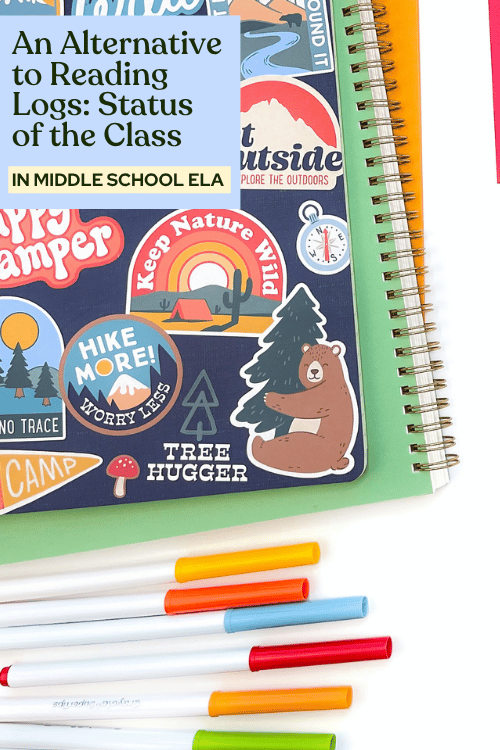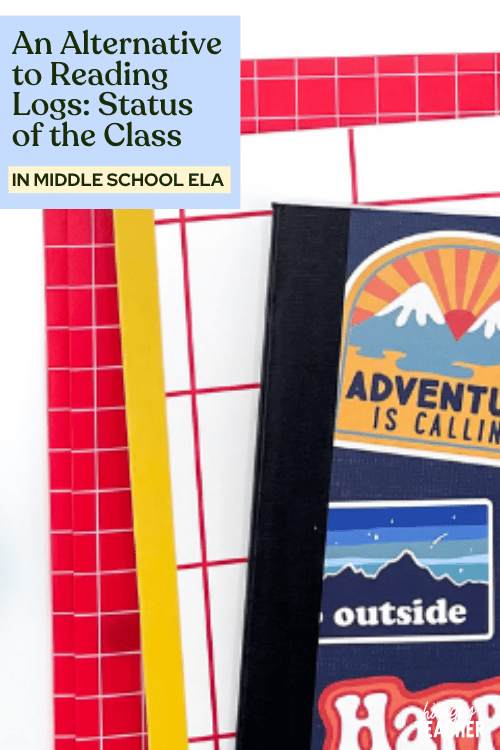hey friend!
I'm Martina.
I provide practical, time-saving strategies that actually work—so you can engage your students, teach effectively, and reclaim your time from the exhausting planning-grading cycle.
Browse Our ELA Resources
An Alternative to Reading Logs: Status of the Class
Something we underestimate as teachers is the magic that can happen with independent reading. When students can pick out their own books and explore new authors and genres, they build on (or ignite) their love of reading. As an ELA teacher, you have the responsibility of both encouraging independent reading and holding students accountable for that reading (which can get tricky). Traditionally, teachers have used reading logs to stay in the loop with what their students are reading. In all honesty, I’m not the biggest fan. So I’m making a case for ditching the reading logs and replacing them with a more effective tool: status of the class.

Why You Should Ditch Reading Logs
Reading logs seem like a simple solution to tracking your students’ reading, but in my experience, the downsides outweighed the benefits. Reading logs are ineffective most of the time because students are more worried about filling out their reading log than enjoying the experience of reading. This defeats the purpose since we don’t want reading to feel like a chore.
Middle schoolers can be challenging because the “reading is a chore” mindset can be really ingrained in students. Using reading logs can further that mindset as reading becomes another task on their to-do list instead of something they genuinely have an interest in and are doing from a place of enjoyment.
The Alternative to Reading Logs: Status of the Class
So, instead of reading logs, what should you use? The winner in my classroom was status of the class.
What is Status of the Class?
Status of the class is a daily check-in that tracks students’ independent reading progress. Typically this check-in is done verbally during warm-ups or at the end of class, but you can also walk around and collect the information 1:1. This is different from reading logs because, as the teacher, you collect and look at the information daily. It’s more personal.
When I was in the classroom, I had a binder for each class period. Each student had a page within the binder. On their sheet, there was a space for the title of the book they were reading, the page number, and space for notes on when students finished or abandoned a book.
How to Use Status of the Class
Sometimes the best way to understand how a strategy works is to see it in action. Here is what status of the class looked like in my daily routine.
During the last 20 minutes of each class period, my students would independently read. At that time, I would start status of the class. I’d call out each student’s name, and they would reply back with their status for that day.
For example, a student might respond with, “Freak the Mighty, page 35,” and another with, “I finished Ungifted yesterday, and now I’m on page 4 of Ghost.” It’s the same information as a reading log, but with your personal check-in.
Status of the class is pretty quick, too. It only required 10 seconds of my student’s time, and then they returned to reading. Plus, the responsibility to write and collect that information was on me, not them, so they could focus on reading.
Status of the class was a regular part of our routine and gave me a ton of insight into how my students engaged with books. For example, if a student was constantly abandoning books, I knew that our next conference would focus on selecting books they would enjoy reading.

Problems to Look Out For
Status of the Class will only be helpful as a replacement for reading logs if you take the information students give you and use it to inform your conferences. This is critical to show students that you are genuinely invested in them as readers and that they’re not just checking off a box.
When you look over your Status of the Class sheets to plan conferences, look for these common problems:
#1 Students Abandoning Books
If every time I did a status of the class, a student called out a different book title, that was an indicator for me that they were frequently abandoning their books. Of course, as readers, we know that students aren’t going to finish every single book they start. But if it has become a pattern, it should be addressed during your conference. This student probably needs guidance on self-selecting books and may need support finding a genre or subject matter they really enjoy.
#2 Students Reading Slowly
Similarly, if during each status of the class, a student is only reporting a few pages of progress, I recommend paying attention to that pattern. Perhaps this student is choosing books that are too difficult for them, or maybe they are not using their reading time wisely. This can be addressed during conferences with a conversation to determine what is creating the challenge. The solution could be as simple as helping the student find a book that is appropriately challenging or choosing a less distracting area of the classroom during independent reading.

#3 Students Reading Too Quickly
The other side of the coin is students flying through their books. This could indicate that they’re not actually reading closely or that the books they’re choosing are too easy for them. During conferences, you can guide them to choose books that they’ll enjoy and will also challenge them. We want students to love reading and be able to practice the skills we’re teaching in class, so if they’re reading too quickly, we can make some adjustments to ensure that is happening.
If you keep an eye out for those challenges, I know that status of the class can replace reading logs in your classroom. This tool is effective, efficient, and will help support your classroom reading community in ways reading logs cannot. You can learn more about building a reading community in your classroom here.
Want a sneak peek at teaching The Hungry Teacher way—with support, structure, and strategy?
When you join the waitlist for The Hungry Teacher’s Hub membership, you get three free classroom-ready resources: a theme unit, an expository writing unit, and a grammar unit introducing mentor sentences. Plus, you’ll get immediate access to a selection of exclusives from the Hub, including editable sub plans, pacing guides, and more.
No strings attached. Just resources you can use right now—and a heads-up when the Hub opens.
3 Free Middle School ELA Units—yours to keep!
JOIN THE WAITLIST + A FREE GIFT
Where to next, line leader?
Welcome to The Hungry Teacher! We create resources that are easy to use, practical, and get results. Teach with confidence—and make it home before dinner.
xo, the hungry teacher